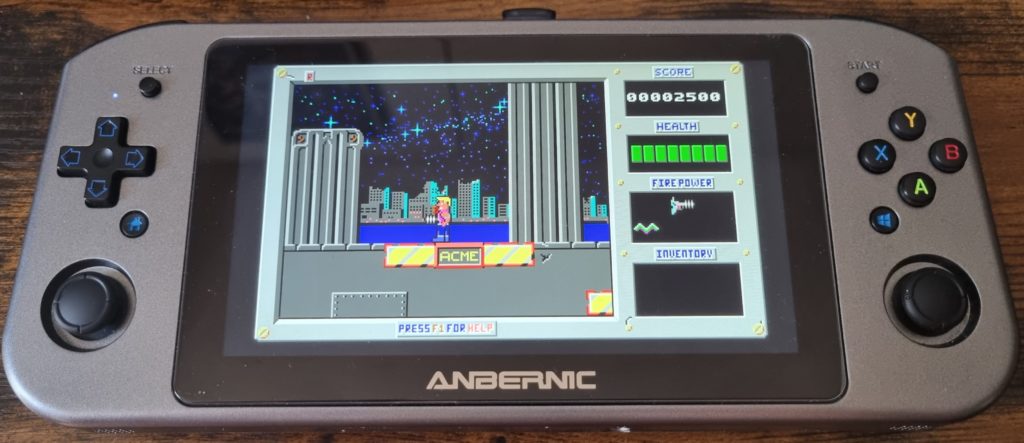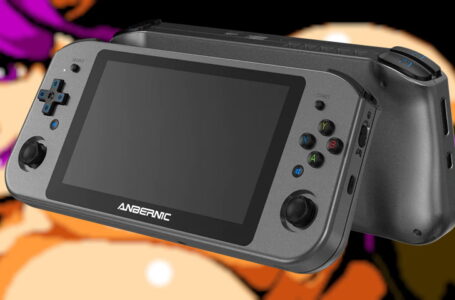A week later: how do we feel about the Anbernic Win600?
Last week, I got my hands on an Anbernic Win600, a new device from one of the most popular manufacturers of emulation handhelds. Unlike the company’s other devices, the Anbernic Win600 is positioned as a handheld PC rather than specifically an emulation console; to that end, it comes preinstalled with a relatively bare-bones version of Windows 10 rather than a preconfigured emulation-centric operating system, and from there it’s up to you to choose what you do with it.
My first couple of days with the device were primarily spent fiddling around with it and determining the best way I wanted to use it. Once I’d figured that out, I was able to simply settle down and enjoy it — and I most certainly have been enjoying it. While the device has its flaws, and it’s certainly worth shopping around and investigating its competitors depending on your own specific use case, I’m overall very impressed with it, and glad I picked it up.
So let’s take a look at what I’ve learned over the course of the last week or so.
Battery life kinda sucks
I wasn’t expecting particularly good battery life from the Anbernic Win600, particularly from the base model, which has a smaller capacity battery. Nonetheless, it’s worth noting that you’ll be lucky to get a couple of hours of playtime out of this thing before needing to plug it in and charge it. You can continue playing while charging, at least — though note that the device only ships with either EU or US power adapters, so if you’re in the UK you’ll need to provide your own suitable USB-C power adapter. A generic laptop one does the job just fine.
The battery life issue actually isn’t a huge problem for my own personal use case; I picked up the Anbernic Win600 primarily so that I could play games (particularly visual novels) in bed, since our bedroom is where our air conditioning unit is. While in bed, it’s no problem whatsoever to plug the device in and play off the mains — and two hours or so is more than enough to allow me to take it to the toilet for a particularly troublesome poo without having to interrupt my gaming session.
Choosing (and sticking with) a main OS
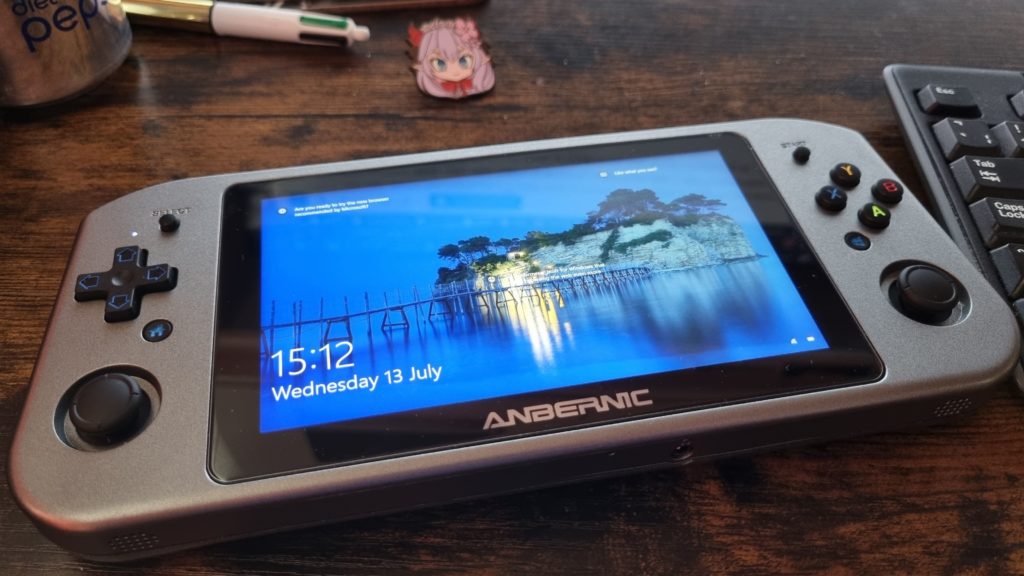
One of the main selling points of a device like the Anbernic Win600 is that it can be an alternative to Valve’s own Steam Deck — indeed, the official website for the Anbernic Win600 even provides USB restore images for the Steam Deck software that can be installed on the device. (Thankfully, it also provides a Windows 10 restore image should you, like me, change your mind.)
I gave the Steam Deck variety of SteamOS a go for a bit and I can certainly see the benefit if your primary use case for the Anbernic Win600 is Steam gaming. Navigating and managing your Steam library is a breeze, and thanks to the impressive Proton technology, you don’t even need to worry about games having Linux-specific versions available, because more often than not the Windows versions will work just fine.
SteamOS’ main benefit is that because it’s an operating system with just one real function in mind — running Steam — it’s pretty lightweight, which leaves plenty of internal storage free to install games and have them always ready to go. However, if you want to do anything more complex with it, it does have a desktop mode and the ability to install new applications — though if you’re unfamiliar with Linux and the obscene amount of jargon that surrounds it, you’re probably best off not tinkering around with it too much.
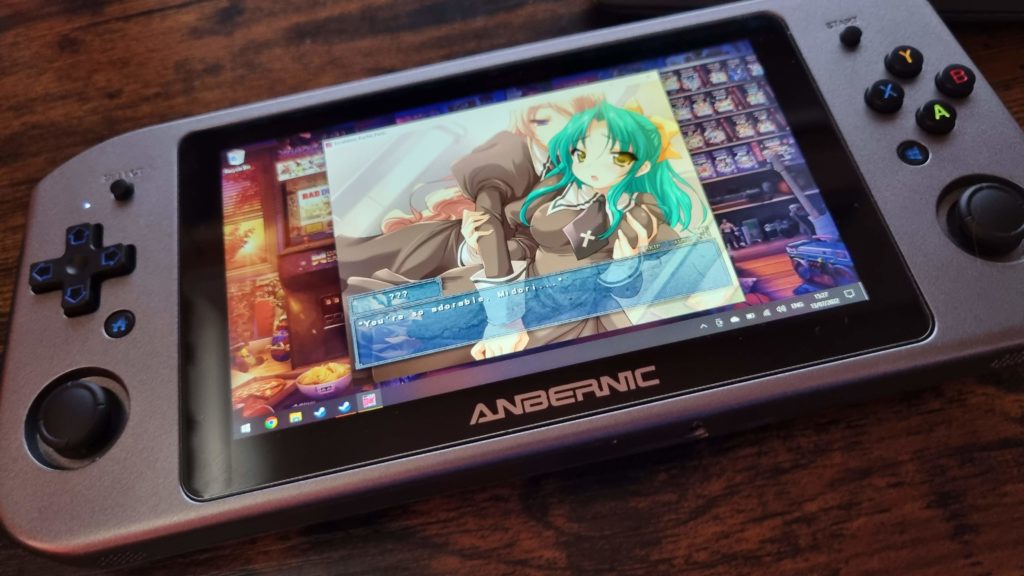
After a bit of fiddling and determining that deciphering Linux-speak was more trouble than it was worth just for the sake of getting some old visual novels running full-screen, I decided to switch back to Windows 10. And while there are some compatibility issues there also — once again with older titles — I feel more confident that I can find ways to resolve them that aren’t incredibly confusing. (“Just go to this Git page!” they say, not telling me that said Git page presents me with a huge list of files and no indication of which one I’m supposed to download, click on or do anything with.)
Note that this is not a slight against Linux users in any way; SteamOS clearly has plenty of potential for power users who are familiar with Linux, and as such it may be a good choice for some Anbernic Win600 owners who do have a good degree of Linux literacy. As someone who grew up with MS-DOS and Windows, though, I’m not in a position where I really want or need to spend time learning a new operating system just for one device in my house. Windows 10 on the Anbernic Win600 does the job, and it does it well.
In fact, I’d probably argue that it does the job better than SteamOS in this instance, because the device has clearly been designed with Windows in mind. There’s a virtual keyboard button on the side of the device, for example, and this doesn’t work in SteamOS, but it works just fine in Windows. Indeed, getting a virtual keyboard to appear at all in SteamOS’ desktop mode was a massive pain in the arse, and one of the main reasons I couldn’t be bothered to continue with it.
Steamy Windows
Using Steam with the Anbernic Win600 is most practical using Steam’s Big Picture mode, as this allows for easy navigation of your Steam library using simply the controller buttons on the device. You can use the touchscreen if you prefer, but honestly the controller buttons do the job just fine for most things.
One issue I found with Steam is that the “Home” button on the controller, intended to be an equivalent to the Guide button on an Xbox controller, does not, under any circumstances, pop up the Steam overlay or allow you to use “Steam Chord” shortcuts to do things like, say, take screenshots or magnify the screen from your controller.
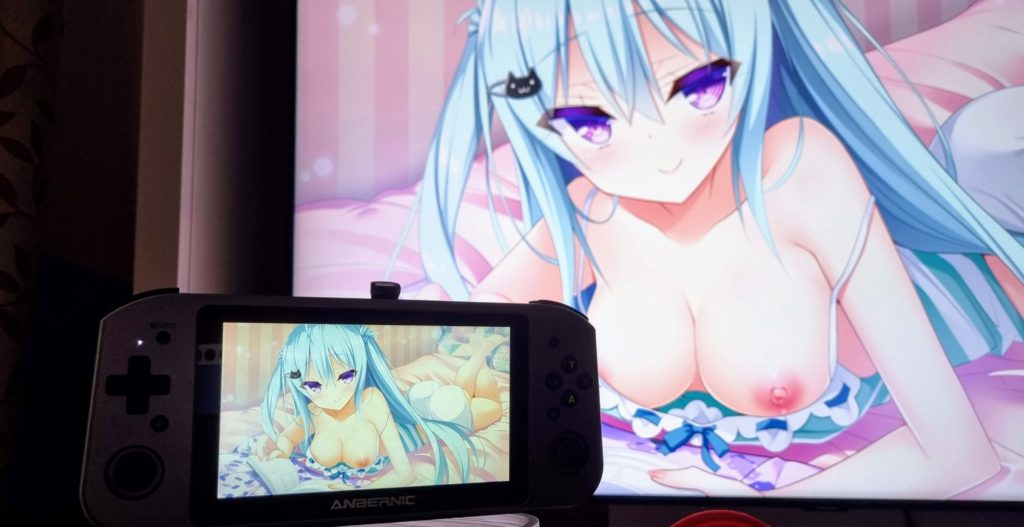
After a bit of research, I discovered that this issue relates more to Microsoft’s introduction of Game Bar to Windows 10 a few years back than Steam itself, and thus it’s not an issue specific to the Anbernic Win600. It’s a pain, though, as I haven’t yet been able to resolve it, despite turning Game Bar off completely. Steam Big Picture Mode’s excellent controller configuration does allow you to assign any controller button to functions such as taking screenshots, though, so in the case of games with simple controls it’s not a major issue, but it would be nice to be able to get Steam working as intended.
For general Steam gaming, Steam’s Big Picture Mode is almost as good as the dedicated experience offered in SteamOS’ Gaming Mode. It’s kind of surprising that the two don’t match their layout and UI better, but I guess they wanted to make the two distinct from one another so you would always remember if you were running SteamOS, or Steam under another OS.
As we noted in our initial thoughts, performance on modern 3D games with fairly intense graphics on the Anbernic Win600 is fairly poor, but keep your expectations in check and maybe explore some games from 10-15 years ago (which can still be lookers!) and you might find some pleasant surprises along the way. Meanwhile, 2D indie stuff runs like a dream; the handheld form factor and excellent screen made The Sword of Succubus a complete pleasure to play on the Anbernic Win600, and indeed I did my whole playthrough on the device rather than the desktop PC I have, to date, more traditionally used.
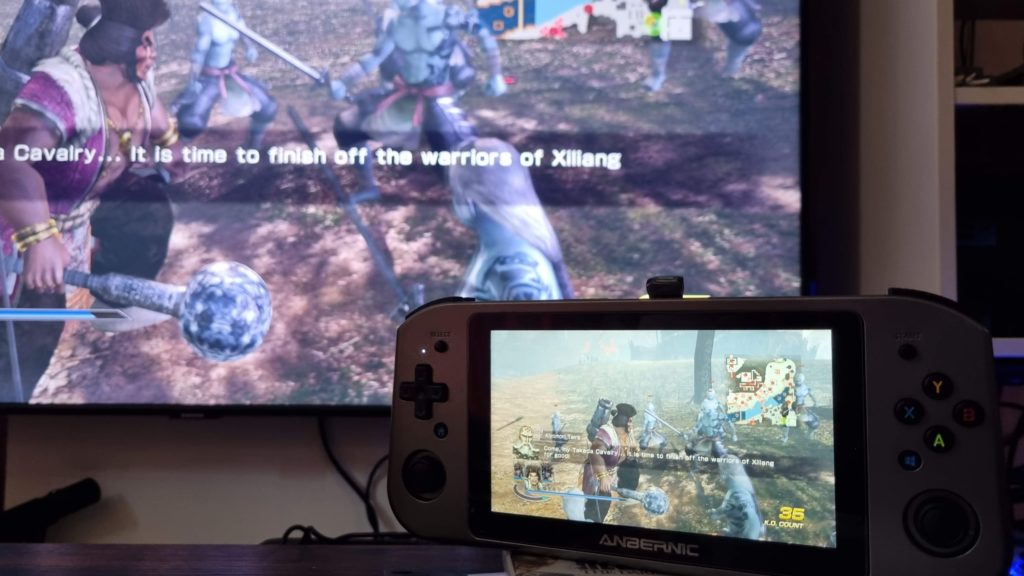
That said, if you have a decent gaming PC in your house, bear in mind that you can also stream games — including non-Steam titles you’ve added to the Steam client — to the Anbernic Win600. Performance is pretty impressive, too; a visually busy title like Warriors Orochi 3 Ultimate Definitive Edition kept up with things at a full 60fps without breaking a sweat and with no discernible input lag, while this feature is obviously ideal for more sedate stuff like visual novels and adventure games. Plus with the smaller screen of the Anbernic Win600, the sort of visual artifacting which sometimes becomes apparent when attempting to stream games on a big TV is barely noticeable.
There was the occasional judder in sound and image quality due to network fluctuations, but on the whole the Steam streaming experience was very playable and a lot better than I expected. It’s a great use case for the device if, say, you have Warriors Orochi 3 Ultimate Definitive Edition installed on your good PC but you want to go play it in bed upstairs where the air conditioning is. For, you know, example.
Retro gaming heaven with Batocera
Probably my favourite use of the Anbernic Win600 will come as no surprise to anyone who has owned a previous Anbernic device: its retro gaming potential. While the system doesn’t come pre-prepared for retro gaming like other Anbernic devices does, it’s straightforward to install your own retro gaming-centric OS on an external USB device and boot from that when you want to play classic games instead of Steam titles. Pick something like the dinky SanDisk Ultra Fit range and it’ll even sit almost flush with the device, allowing you to keep it connected at all times without making the unit unwieldy or impractical.
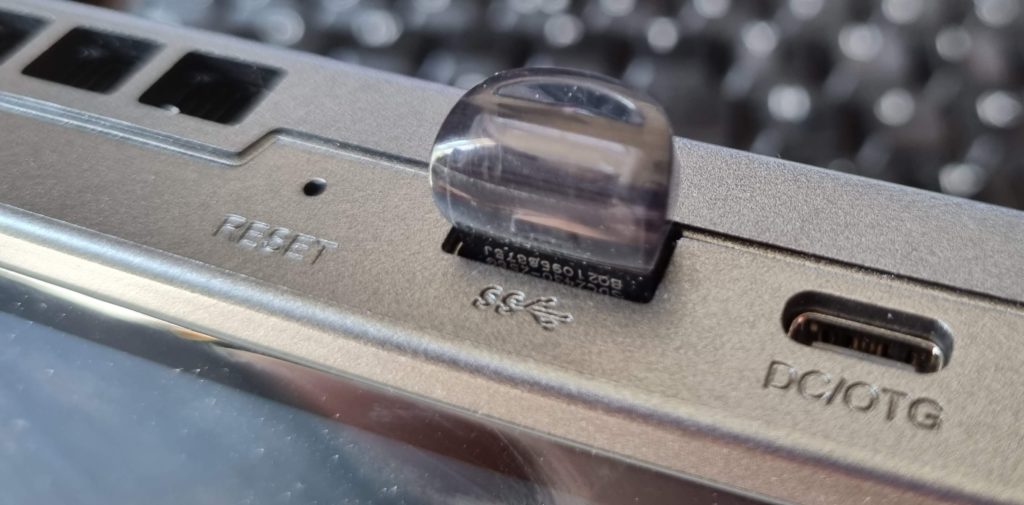
Prior to picking up my Anbernic Win600, I’d heard good things about Batocera, a specially built version of Linux specifically designed for retro gaming boxes such as handhelds, Raspberry Pis and suchlike. So, as noted in our first impressions article, I installed Batocera and loaded it up with a selection of ROMs — and now I’m unbelievably happy with the Anbernic Win600 as a retro gaming machine.
Once you’re over a few things that need tweaking to get Batocera running and displaying correctly on the Anbernic Win600, it’s an absolute joy to use, and incredibly easy to work with. The device’s built-in Wi-Fi allows you to connect directly to Batocera through Windows to copy ROM files over the network, and the incredibly helpful Batocera wiki offers plenty of advice on how to get more obscure or temperamental systems — such as arcade machines and MS-DOS titles — up and running.
One of the nice things about Batocera is that it uses an established but relatively “static” form of classic arcade emulator MAME as its default arcade emulator. Known as MAME2003Plus, this is a well-maintained branch of MAME that works well today despite its dated-sounding name — and its distinct advantage is that it’s very easy to find a reliable, completely working, well-maintained ROM set for every arcade game you could possibly think of. This makes getting up and running with arcade emulation, which can be particularly challenging for emulation newbies, an absolute breeze.
Likewise, the excellent advice contained in the Batocera wiki allowed me to get a variety of classic DOS games working with very little faffing around. I’d previously never even considered attempting to put DOS games on a handheld device like this, but now I don’t want to live in a world without handheld Duke Nukem and Bio Menace.
With the amount of variables emulators can introduce to the mix — particularly with more complex systems like arcade machines and MS-DOS games — you may find yourself having to tinker a little with configuration files manually. Thanks to the excellent documentation, and the fact that Batocera itself is designed to be very difficult to “break”, it doesn’t take long to get things working exactly the way you want them to, though.
I haven’t yet tried some of the more power-hungry systems such as Dreamcast, PS2, Xbox and beyond as yet, but reports elsewhere on the Internet suggest that performance on the Anbernic Win600 under Batocera is very good for all of these except for PS2, which is notoriously tricky to emulate anyway. GameCube is supposed to work very well, though — and with that system’s library rapidly entering “cult classic” (and “very expensive”!) status, the Anbernic Win600 could be a great way to explore some classics you might have missed out on.
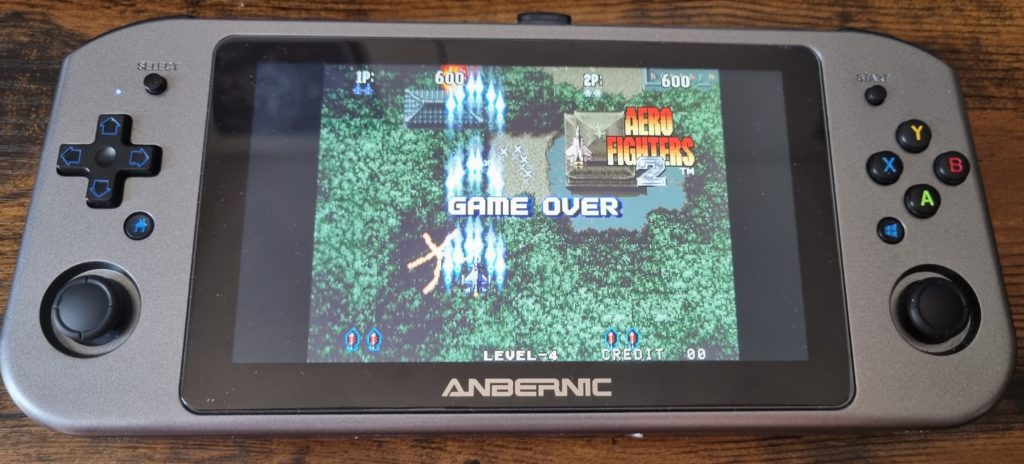
Final thoughts
I’m very happy with the Anbernic Win600. Could I have got a device with better performance had I waited a bit? Sure, but that is literally always the case with every kind of consumer tech out there. As it stands, the Anbernic Win600 does everything I wanted it to do, and it does it right now for a reasonable price.
It’s perhaps an overly pricy option if you’re looking for something to use as a dedicated retro gaming handheld and nothing else — but that’s why the rest of Anbernic’s range exists — but for hybrid purposes, such as what I’m using it for, it’s ideal.
It is by no means a substitute for a dedicated gaming PC, but if you want a means of enjoying all manner of different titles in a portable form factor — and perhaps even getting a bit of work done, if you don’t mind working on a very small screen and have a suitable USB hub to connect keyboard and mouse — the Anbernic Win600 is an eminently worthy addition to your collection of gaming gizmos and gadgets.
Join The Discussion
Rice Digital Discord
Rice Digital Twitter
Rice Digital Facebook
Or write us a letter for the Rice Digital Friday Letters Page by clicking here!
Disclosure: Some links in this article may be affiliate links, which means we may earn a small commission if you make a purchase after clicking on them. This is at no additional cost to you and helps support Rice Digital!
- Letter from the Editor: passing the torch - June 30, 2023
- Super Woden GP 2 is looking promising - June 30, 2023
- Inti Creates is making a 32 bit-style Love Live action platformer - June 26, 2023



